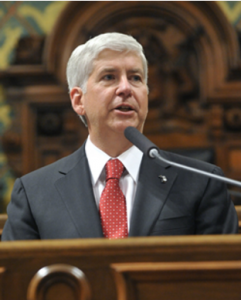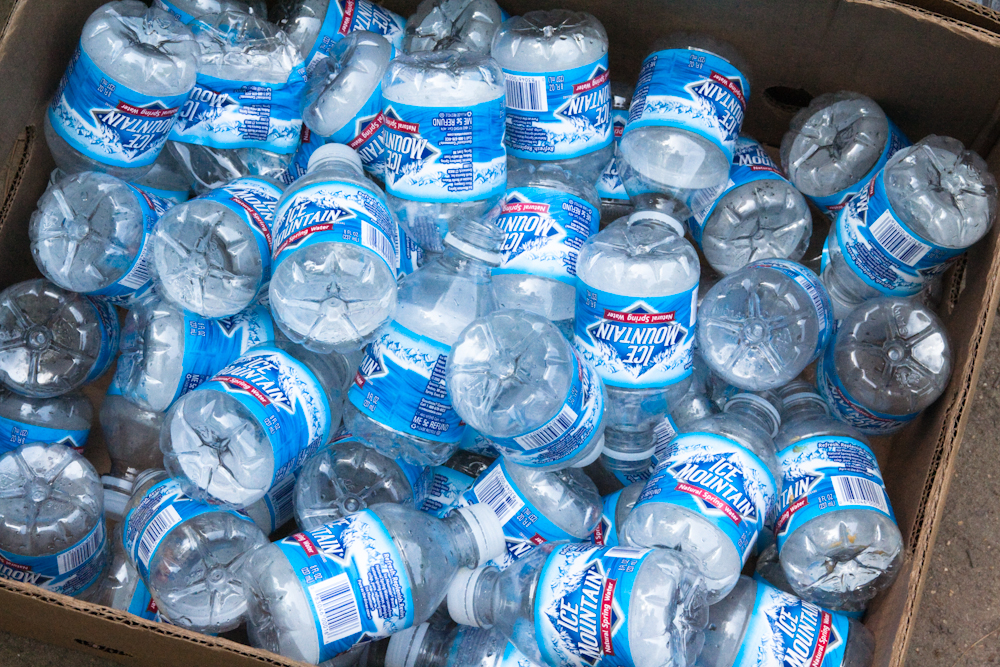
Free bottled water throughout the summer
100,000 bottles per week until Labor Day. 4,200 cases. Three semi-truck loads.
That amounts to 1 million 600 thousand bottles of water over the next several months.
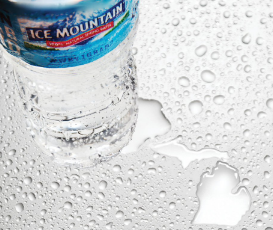
Nestle Committed to Michigan, Photo by nestle-watersna.com
Nestle says it will restock Flint’s bottled water supply for at least 16 weeks.
The announcement came in the wake of the State of Michigan’s decision to stop giving free bottled water to residents four years after the Flint Water Crisis began.
The state ended the free bottled water program last month, saying water quality had been restored.
That didn’t go over so well for some Flint residents who say they believe they still have lead in their water, the color of their tap water still runs a garish orange or brown color, and some say they still get rashes when they take baths and showers.
But state officials say the water that comes out of the faucets in Flint resident’s homes meet all the requirements of the Safe Drinking Water Act and Lead and Copper Rule.
Gov. Snyder: “The need for bottled water has ended”
Michigan Governor Rick Snyder issued this statement: “We have worked diligently to restore the water quality and the scientific data now proves the water system is stable and the need for bottled water has ended.”
State officials say the state spending on bottled water for Flint residents was averaging about $22,000 a day.
Flint’s Mayor Karen Weaver isn’t happy about the cut-off of the state’s bottled water supplies. She’s threatened to sue the state over this decision. But meanwhile, there’s some good news:
It’s Nestle to the rescue.
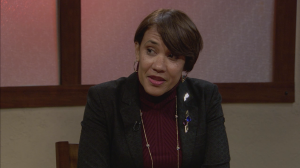
Flint Mayor Karen Weaver, Photo courtesy of American Black Journal
Mayor Weaver is praising Nestle Waters, the company that sells several brands of bottled water including Ice Mountain which is distributed in the Midwest, for helping out by providing massive amounts of bottled water throughout the summer months. Mayor Weaver calls it a “generous donation”, saying “I want to thank Nestle for the willingness to help the people of Flint. Nestle will deliver the water directly to the three Help Centers located around Flint, which is where the water will also be distributed to Flint residents.”
Great Lakes Now decided to talk directly with Nestle to find out more.
Jason Manshum is Community Relations Manager with Nestle Waters North America. He says the decision to donate bottled water until Labor Day is simply part of Nestle’s continued program to help Flint residents which has been going on since the fall of 2015.
“The need for clean safe drinking water is still there”
Manshum says a coalition of companies including Nestle and Walmart have provided six and a half million bottles of water in total to the Flint Public Schools since the Flint water crisis began. Of that total, Manshum says Nestle provided one and a half million of the bottles. Manshum says, “In 2018, we provided the Flint Public Schools with grant money so they could purchase bottled water themselves through the end of the school year as well as water filtration systems. Then, working with our local partners in Flint – primarily the United Way and the Food Bank – we learned that with the upcoming summer months, the need for healthy hydration and clean safe drinking water is still there. So, working again with those partners, we devised a plan to get us through the hot summer months through Labor Day, where we will be making regular, recurring water deliveries at three different locations set up through the food banks and local churches.”
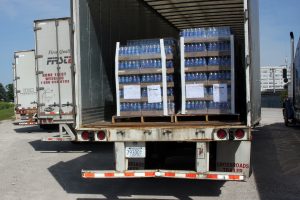
Pallets of bottled water are loaded in trailer trucks, Photo by Robert Kaufmann via wikimedia cc 3.0
Manshum says the deliveries began May 10th and will happen every Monday, Tuesday and Thursday morning through the summer.
Manshum tells Great Lakes Now the donation isn’t all that unusual.
He says, “This is why I and many of my colleagues are so proud to work at Nestle. We do this type of work all across the United States when communities need it. This isn’t exclusive to Flint or even the State of Michigan. Last year alone, in 2017, we gave more than 5 million bottles of water to help people impacted by the hurricanes and the wildfires across the country last year. On a regular basis, we give cases of bottled water to first responders and other local organizations like non-profits. It really goes to the root of what drives our organization: to be good stewards not only of the water but good stewards in the community where we live and work.”
Manshum did not say the decision to provide the 1 million 600 thousand bottles of water through Labor Day was directly related to the State of Michigan’s decision to stop providing free bottled water to Flint residents. But he did say, “As the transition back to drinking tap water is happening, we need to make sure that if there are any concerns or need for additional water, that we can help deliver that, and continue to be good neighbors for that community.”
“There is no safe level of lead for children”
Is Flint’s water safe?
In an article in Mother Jones, Nathalie Baptiste writes, “During the crisis, one resident’s water had 397 parts per billion of lead. There is no safe level of lead for children, but the federal limit of lead in water is 15 parts per billion. As part of a $450 million federal and state aid package, Flint residents were able to receive free bottles of water for cooking, drinking, and bathing at various water distribution centers. By the end of 2016, more than two years after the crisis began, lead levels in the city had finally fallen to 12 ppb.”
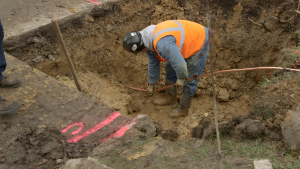
City workers replacing pipes in Flint, Photo courtesy of the Blue Economy
In the most recent testing in mid-April of this year, the Natural Resources Defense Council released a report that found lead levels well below the federal action level of 15 parts per billion in a sample of 92 homes, and a Michigan State University researcher found a lead level of 4 ppb at the homes that were tested.
Lead levels may have fallen to safe rates according to state and federal officials. But all the pipes in the city haven’t been replaced yet. That just doesn’t add up for many Flint residents.
And one thing that’s hard to measure: trust.
Some Flint residents say no matter what the numbers show, they are going to have a hard time believing their water is safe to drink or bathe in since they say they were lied to by government officials repeatedly.
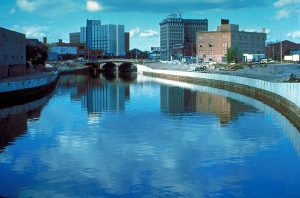
Flint River, Photo by U.S. Army Corps of Engineers via Wikimedia
Flint’s water crisis began when the city of Flint switched its water source from Lake Huron to the Flint River. The water from the Flint River wasn’t treated correctly, so it wound up leaching the lead off old pipes in resident’s homes, schools and other buildings all across the city. Residents noticed smelly discolored water right away. But they were given no alternative to cooking, drinking and bathing in water contaminated with lead for almost two years. Thousands of children wound up with lead in their bloodstreams. 12 people died from Legionnaires disease, an outbreak that was linked to the decision to switch to the Flint River water source. More than a dozen government officials face criminal charges. A new legal settlement reached at the end of April calls for a more than 4-million dollar investment in medical screening programs to find out the impact of the lead poisoning on children and adults.
There are many other controversies that continue to erupt in the wake of the water crisis, and recently Flint’s Mayor has asked the EPA to intervene on Flint’s behalf. ( Letter to EPA regarding cancellation of FWICC Meeting)
Though many of Flint’s faulty, lead-lined pipes have been replaced, the entire city won’t have new safe pipes until the year 2020. And many residents say they should have access to clean bottled water until every single household has safe drinking water.
That’s why so many people are applauding Nestle’s decision to step in to help Flint.
Nestle Waters Manager of Community Relations Jason Manshum tells Great Lakes Now the response to Nestle’s decision to provide bottled water to Flint residents through the summer has been extremely positive.
But Shea Howell with the James and Grace Lee Boggs Center to Nurture Community Leadership who writes a weekly column called “Thinking for Ourselves” has a different take.
“A Public Relations Stunt”
She calls Nestle’s massive donation a “public relations stunt.” The community activist writes, “First there is the obvious problem that Nestle is “donating” water that the entire state, and in some ways much of the globe, is paying for. Nestle is pumping 400 gallons a minute out of the underground springs that feed the Great Lakes. For this desecration it pays the state $200 a year. That is less than many people in Flint pay for water on a monthly basis. They are doing this in spite of the largest public outcry on record for the Michigan Department of Environmental Quality. Over 80,000 people objected to the authorization to nearly double the amount of water Nestle takes and puts into little bottles.”
Howell says, “Nestle’s efforts to deflect our concern is foolish. The people of Flint, like people everywhere, deserve clean, fresh, affordable water. Until Flint’s entire water system is replaced, the State has a moral obligation to provide bottled water. We need a thoughtful, region-wide policy that recognizes our responsibilities to protect the waters of the Great Lakes and to respect the people and life they support.”
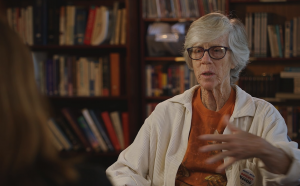
Peggy Case, President of Michigan Citizens for Water Conservation , Photo courtesy of Tapping the Great Lakes
Peggy Case, President of Michigan Citizens for Water Conservation (MCWC) echoes Howell’s concerns. She says , “The people of Flint do not want “charity” from Nestle in toxic plastic bottles. They want the State to fix what it broke by fixing all the pipes, hot water heaters, and service lines, asap. They deserve the same disaster treatment given to Toledo when its water was tainted by the algae bloom in Lake Erie. They want the bulk deliveries of clean water they deserve. Nestle’s ploy is such an insult. Where are the numbers on how much profit they have made from selling our water back to the people of Flint? When will the State move to deliver clean water not tainted by micro-plastics, lead, bacteria, and other toxins to the people who have done without for four years?”
(Editor’s note: Flint residents who need water, filters, or other supplies or have questions should call 211 or (810) 410-1138.)
Featured Image: Ice Mountain Water Bottles, Photo by Steven Depolo via flickr cc 2.0


